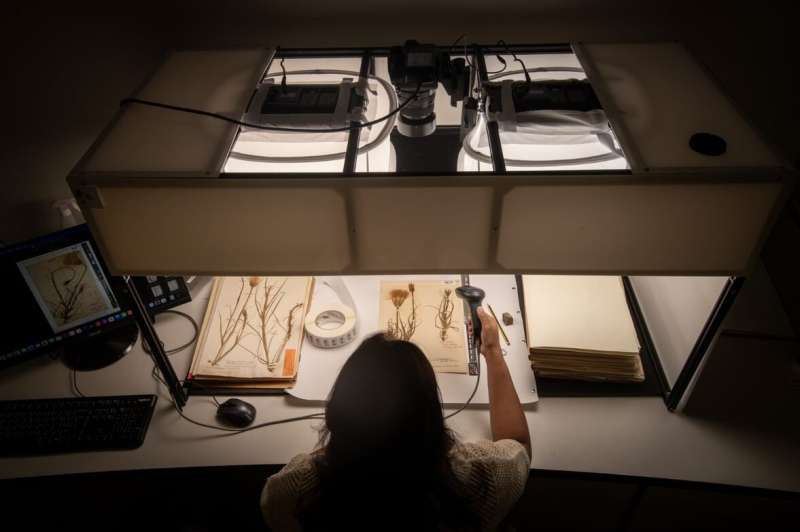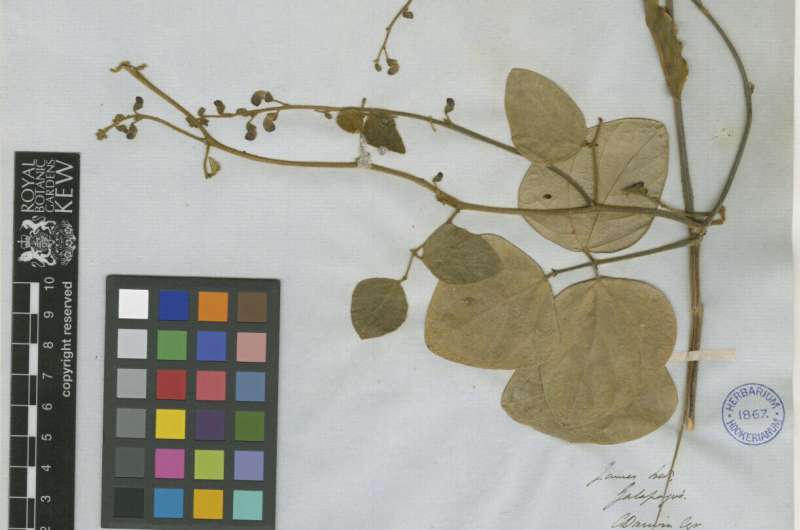This article has been reviewed according to Science X's editorial process and policies. Editors have highlighted the following attributes while ensuring the content's credibility:
fact-checked
trusted source
proofread
A treasure trove of knowledge: The Royal Botanic Gardens, Kew digitizes 1 million specimens in groundbreaking project

The Royal Botanic Gardens, Kew has hit a momentous milestone in its mission to digitize its entire collection of plant and fungal specimens. RBG Kew's Digitization Project has reached the one millionth specimen scanned, marking a major achievement in an ambitious four-year initiative.
The team behind the multi-million-pound project is unlocking a wealth of information about life on Earth, including the data about rare historical specimens unavailable anywhere else.
The project, which began in March 2022, is making the specimen records and scanning images from RBG Kew's herbarium and fungarium specimens so they can be freely accessible to anyone, anywhere in the world. This includes scientists who will be able to use the digitized specimens to aid research via a new Data Portal expected to be live in the autumn.
The project's digital repository of plant and fungal specimens will offer invaluable insights into some of the major challenges facing the planet, including mapping extinction risks for individual species and understanding the potential impact of climate change on ecosystems, common crops and local communities.
"Every specimen we have holds crucial data that provides a snapshot of what was growing in a particular place at a particular time. This allows us to monitor changes in plant distribution over time for a given area helping us understand how our planet's climate is changing and how to adapt to ensure food security for future generations," said Dr. Sarah Phillips, Digital Collections Research Leader, RBG Kew.
RBG Kew's historical collections are being leveraged to understand how plant and fungi have evolved with changing environmental conditions and agricultural practices, to identify useful genetic diversity that may have been lost along the way. Similarly, researchers are using data from RBG Kew and other major institutions in a wide variety of ways, from revealing that 60% of wild coffee species are threatened with extinction and mapping the status of endangered species of rosewood to understanding variations in myriad legumes used for food over the ages in different cultures.
The digitization of RBG Kew's plant and fungal specimens is not only important for the scientific community but also for the general public. It will allow anyone with an internet connection to access the information and images of these specimens and learn more about the incredible diversity of life on our planet.
Dr. Paul Kersey, Deputy Director of Science—Research at RBG Kew, said, "Reaching this milestone is a significant achievement and a testament to the dedication and hard work of everyone involved in our largest project to date. What is most exciting is that we're already realizing the impact of this work with researchers actively using our digitized collections to tackle some of the biggest challenges facing our planet today. With this in mind, the impact of unlocking our entire collection of over eight million herbarium and fungarium specimens will be immense."
Collected by Charles Darwin
Collected on his pioneering expeditions to the Galápagos Islands, Charles Darwin's remarkable Phaseolus mollis Hook is now part of RBG Kew's digitized collection. Darwin's specimens have contributed to a deeper understanding of some plants' evolutionary history, ecological relationships, and conservation needs within areas such as the unique Galápagos Islands ecosystem. Preserving this invaluable botanical artifact digitally ensures its accessibility for future generations, advancing our knowledge of Darwin's scientific legacy and inspiring a greater understanding of how plant diversity has changed since the 19th century.
Titan arum—one of the smelliest plants in the world
Dubbed the "corpse flower," titan arum (Amorphophallus titanum) stinks of rotting flesh when in bloom, and is an exceptionally rare plant species. It originates from the rainforests of Sumatra, Indonesia, where it faces habitat loss and fragmentation, contributing to its endangered status in the wild.
The species is now immortalized as part of Kew's digital collections, soon to be accessible to researchers worldwide. The digitized data on the titan arum will propel research efforts to understand its taxonomy, ecology, and response to environmental changes. Furthermore, this information will aid conservationists in identifying key regions for protection, implementing conservation measures, and preserving its genetic diversity.

Utilizing the collection to protect Tropical Important Plant Areas (TIPAs) and improve livelihoods
RBG Kew's program to protect Tropical Important Plant Areas (TIPAs) is dependent on using the herbarium collection to first geolocate endangered species before stepping foot in an area. This research helps inform conservation strategies and can influence policy to protect the area from threats such as deforestation.
Digitizing RBG Kew's collections will allow greater global collaboration with researchers around the world as they're able to access this geolocation data stored with a herbarium specimen, therefore allowing them to also assess its distribution in a particular area of interest. This will likely accelerate work into resolving the biodiversity crisis and climate change through conservation assessments and aiding climate modeling.
As part of RBG Kew's Bolivian TIPAs project, experts have been utilizing herbarium specimens to geolocate the location of threatened and endemic species. With this knowledge, the team then worked with local communities to focus on growing three economically useful native legume species, which they could sustainably farm with local forests remaining intact. This project led to local people setting up businesses, creating a value chain with sales of their produce being sold to North America.
1 millionth specimen—Allium ramosum
Nestled within the vast collection and the millionth to be digitized, this extraordinary plant holds a wealth of botanical knowledge waiting to be unveiled. Commonly known as fragrant garlic or Chinese chives, the species is native to Central Asia and the far east of Russia.
By meticulously imaging and transcribing its accompanying label information, Kew has breathed life into this species within the digital realm. The benefits of this digitization endeavor ripple far and wide, offering scientists worldwide unfettered access to this invaluable resource. From taxonomists studying its intricate morphology to conservationists assessing its distribution patterns, the digital record of Allium ramosum serves as a beacon of knowledge and inspiration, transcending geographical boundaries.
An extinct species—Streblorrhiza speciosa
RBG Kew has estimated that two in five plants are at risk of extinction, a sad fate for those species we're not able to protect and save in time. Now digitized as part of Kew's collection is Streblorrhiza speciosa, a perennial shrub known to be from Phillip Island, Australia which is now thought to be extinct in the wild. Kew researchers are working hard with partners in over 100 countries to find nature-based solutions to stop the biodiversity crisis. By digitizing specimens, Kew's historic collection acts a time capsule for species from across the world.
Journey of a specimen—how does digitization work?
Specimens are collected from the cupboards or compactors by the digitization officers and are taken to a nearby imaging workstation. There each specimen is given a barcode, which acts as a unique identifier, and high-resolution photographs are taken of the specimens along with the folders the specimens are kept in.
These images are then uploaded to a software platform where a data entry team based in India transcribe the written information on the folder and specimens. This typically includes what the specimen is, who collected it, where it was collected and when it was collected. Once a sample of the images and data has been quality checked by RBG Kew staff the images and data are transferred from Max to Kew and ingested into Kew's management systems. A team of inhouse digitizers tackle the more complex specimens, including palms, which tend to be large and bulky, and orchids, where frequently many specimens are found on the same sheet. The digitized specimens will be made available to everyone free of charge via a new data portal due to be released in autumn 2023.
Volunteering
Volunteers play a key role in helping RBG Kew digitize its specimens. Comprised mostly of plant enthusiasts, volunteers bridge the gap between RBG Kew staff and the wider community. Since opportunities opened, there have been over 165 volunteers on this project, the volunteering team image about 800 specimens a week and have achieved nearly 9,000 to date.
Ben Hirschler, a retired journalist helps transcribe specimens at RBG Kew. "I've always loved coming to Kew Gardens, and today its mission to understand and protect plants and fungi seems more important than ever. I wanted to find a worthwhile volunteering role after retiring from full-time work and Kew happened to be holding an open day for the Digitization Project just at the right time," said Hirschler.
"I enjoy the feeling that I'm contributing in a small way to spreading knowledge that will support conservation efforts & deepen scientific knowledge. It's fascinating to be immersed in following expeditions that have collected remarkable specimens from the jungles of Borneo or the foothills of Mount Kilimanjaro, often dating back to the 19th century or earlier. In a way, transcribing Kew's specimens is like peeling back history: it sheds light on how plants and fungi were distributed and shines a light on human curiosity going back three centuries."
Provided by Royal Botanic Gardens, Kew


















